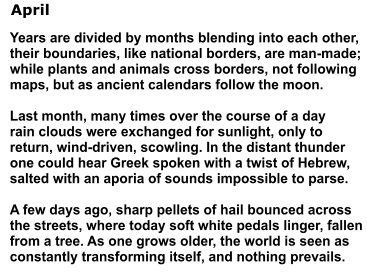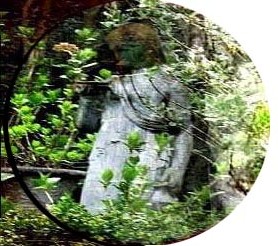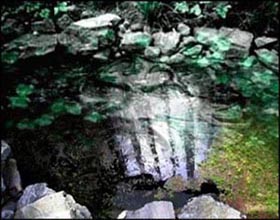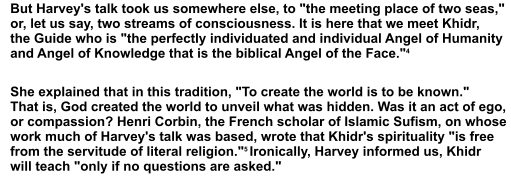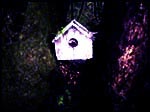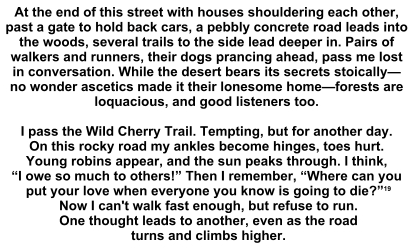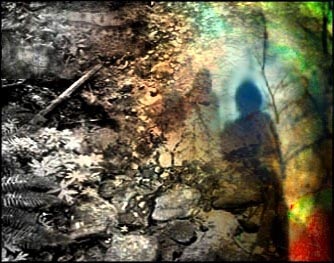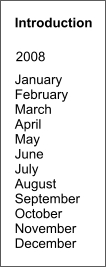 |
|
| April 8. Today is the birthday of the Buddha, the birth of our unborn self. I think also of the Green Tara, the Tibetan goddess who guides one across the Sea of Ignorance (Tara = to cross), because yesterday, on a route that's scheduled to pass through Tibet, the Olympic Torch, being relayed from Greece to Beijing, crossing many lands and seas, inspired protests over China's continuing suppression of the Tibetan People. Like Ancient Greece, Tibet is a place of mythical proportions, where Shangri-La, "the last great cohesive echo that vibrated from Tibet before it fell into ruins...still echoes..."1 Invading Tibet, the People's Liberation Army spread the seeds of Buddhism around the world, as when you hit an old cushion and dust flies. But its hagiography remains carved into the sides of mountains, and the sound of kangling, long trumpets made from human thigh bones, still reverberate through its valleys. To "reinhabit" a place, or a region, as the poet Gary Snyder suggests we must do in order to save the vitality of this planet, we must first learn to see mythologically, exposing the roots of the gods who inhabit the place and brewing them into new visions of modernity. At my father's funeral, after the coffin was lowered, the rabbi asked Mother, Sister, and I to toss a handful of sand "from the Holy Land" into the grave's open mouth. Was it Middle Eastern sand, or did he scoop it from the beach a few miles away?
10. In one of Eliot Pattison's novels about Tibet, what C.G. Jung called a big dream, a Buddhist monk calls, "an awareness event."3 This invested terminology made me think of how we tend to legitimize nonfiction over fiction, as if what's found in the former is more "real" than what is found in the latter. As physicists may never be able to prove what came before the Big Bang, are there answers to epistemological conundrums, or only infinite strings of awareness events? . 12. This month's speaker at Oregon Friends of C.G. Jung was Puanani Harvey. Like last month's speaker, Dr. Harvey is an analyst who lives in Santa Fe. The title of her talk was "The Unveiling of What is Hidden." Unveiling is a hopeful word in sight of the millions of women that a feudal interpretation of Islamic Law condemns to hide behind veils. Calling it "modesty," is this a euphemism for fear of the power of women patriarchal fundamentalist sects can't face?
This time of the year in New Mexico I'd be sick with an inevitable sinus infection. Even in the Pacific Northwest, when the rain stops for a few days and the wind scurries west from the desert, juniper pollen zeros in on my bronchial tubes as if they can grow leaves.
Norman O. Brown is paraphrasing the 13th Century Islamic mystic, Ibn Arabi, who, Puanani Harvey wrote, "was first initiated by his experience with Khidr."8 —
The Christian mystic, Meister Eckhart, said, "The eye with which I see God is the same eye with which God sees me: my eye and God's eye are one eye, one seeing, one knowing and one love."10 If we could have listened in on a conversation between these two masters as they walked along the shore where two seas—the hidden and the revealed—meet, we may have heard "the lost poetry of creation." But “we cannot keep our balance. Myth gives a way to Reason. Revelation to Orthodoxy. We must dance or go mad.”5 The Sufis, the esoteric sect of Islam whose Whirling Dervishes dance themselves into ecstatic states of mind, step away from the madness of "the servitude of literal religion" toward the spirit of Khidr, the Green Man, the Green Tara, all healing deities. In Islamic iconography, the fragrance of deep ecology is represented by the color green. The alternative to this hopefulness is seen in a poem by an inmate of the American prison at Guantánamo Bay:
15. For two days, the weather was unusually warm for this time of year. As I live on the top floor, by evening the heat had penetrated the roof's thin insulation and spread across ceiling and down the walls:
With GPS, laptop, and cellphone, now it is more difficult to get lost. But if you do, who would be hired to look for you?
The Navajos employ 'hand tremblers'—usually women—who go
into a trace
and 'see' where the lost article or person is located. When I asked one such diviner what it was like when she was in trance, she said, 'Lots of noise but noise you can't hear.'13 A phone call from Erasmus High School asking me to update my alumni information, her Brooklyn accent antagonizing mine. How can I say into cradled plastic connected to miles of wires and banks of computers where my life has led in the fifty years since graduation? When she asked, "Any hobbies?," I thought of D.H. Lawrence's story of a hobby horse that carries its young rider "in his green pajamas" into a thunderstorm. Awaiting a glacier. Bending the wind. Directing water and light. The May-green call of the cuckoo and the invisible trace of its flight. Space. The cry of an animal. The bitter taste of daphne. Burying the pond and the dragon-fly. Setting fire to the fog and the perfume of a prescient world." His eyes," Lawrence continues, "blazed at (his mother) for one strange and senseless second, as he ceased urging his wooden horse. Then he fell with a crash to the ground."14 There are shamans in Siberia who use spirit horses to gallop up to the Otherworld. There are also what the scholar of religion, Daniel C. Noel called "neoshamans" who can shape-shift into the imaginal realm15—
. 18. One of the most insidious strategies of conservatives was to repackage Charles Darwin’s “survival of the fittest” as Social Darwinism, in order to promote competition for the common good. We see this in sports, where the competitive spirit enters the circulatory system as a performance enhancing drug. In the marketplace, fair competition can reduce prices, but it is also used by predatory corporations to drive smaller game out of business. Except in procreation and war—where humans have been too successful—interdependency and cooperation, not competition, is nature's plan for the survival of our speices. 22. A dark drizzly morning. on the street that Ursula Le Guin wrote so lovingly about, looking over the displaced bridge.18 To the left, is Forest Park17 (where bears have been sighted). To the right, is the building where I lived my first two years in this city. Further on is the Industrial Park, it's bullying train horns mixed with the mating songs of birds. Beyond are the mountains on whose slopes each winter we measure the depth of our fate. Light cleansing mist, fresh colors woven into a gray blanket. Walking up the steep hill, at some point I pass the house that was a Tibetan Buddhist Center where I went to find clarity and found a room of buddhas, paintings of wrathful deities, an assortment of incense burners, candles, bells and bowls of various sizes. Exactly which house it was, I don’t remember. It seems as distant now as the mysteries of Tibet.
26. James Hillman wrote: "The Greeks didn't have to believe in their Gods. They didn't say, 'I believe in...' they didn't have a word for religion." Most primal people, also, didn't have a word for religion. What we call spirituality was woven into their lives. They had no logo like the cross or the Star of David. "They had no theology," Hillman continued, "they had myths."21 I am not suggesting that we return to "the old ways," but that we learn to accept more natural variegated lives. Must we drain every drop of the earth's blood before we accept that our unquenchable thirst for unrenewable sources of energy is suicide? And that "All healing is about...connecting the earth to the earth inside us all."3
.. 1-
Bishop, P. The Myth of Shangri-La: Travel Writing and the Western
Creation of Sacred Landscape. Berkeley, CA, 1989. |
